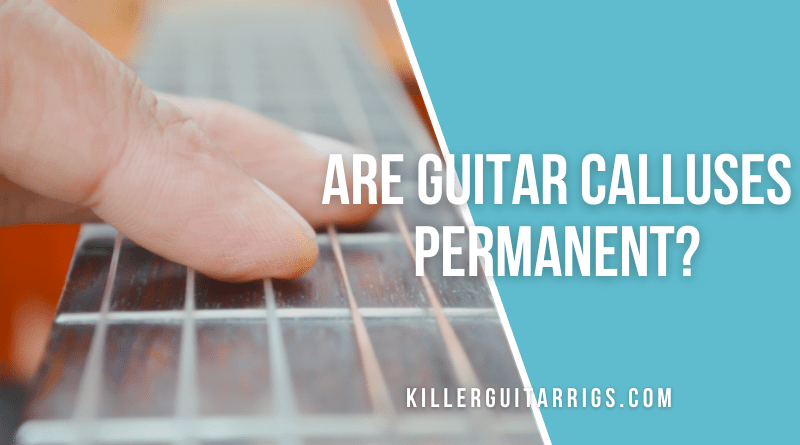Playing guitar is one of the most joyous activities one can experience but it has some major drawbacks too. When you start playing the instrument, be it acoustic or electric, you will notice that your fingertips will harden and it often becomes painful to hold notes on the fretboard.
Calluses are blisters that appear on the fingertips and over time, they harden. But you will be surprised to learn that maybe they are not such a bad thing after all. In this article, we will explore the painful topic of guitar calluses and how we can deal with them:
Contents
What Causes Calluses?
Calluses appear on the fingertips when you subject them to friction from repetitive movements. If you practice finger exercises or play the fretboard extensively and over a long period of time regularly, you will notice blisters on your fingertips which can make them sore and painful.
Since your fingers are not used to this constant motion and friction, the skin gets irritated and your fingertips sore. Sometimes calluses can even develop overnight.
While this is generally no cause for concern, if your calluses start to bleed excessively or they become inflamed and very painful, then you might consider asking a doctor for some advice.
Guitar Calluses: Good Or Bad?
While it can be painful to play guitar when you have newly developed calluses, the good news is that if you can brave through the initial discomfort then it gets a lot easier to deal with them over time since they harden.
What most musicians do not realize is that calluses make it easier to play guitar. Since the skin on the fingertips is hardened, it makes it easier to hold down the strings on the fretboard. The numbness caused by them also helps one play for longer periods without feeling discomfort. Additionally, you will be able to slide on the strings and play hammer-ons with significant ease because of the hardened fingertips.
Calluses may start appearing on your fingers within a few days of playing guitar. In about two to four weeks, you will notice that the skin has considerably hardened and you no longer feel any discomfort.
Think of playing guitar as working out for the first time. Your body will feel sore for the first few days but over time it gets easier and the pain simply fades away.
Caring For Your Calluses
There is no reason why you should be afraid of guitar calluses, but here are some of the ways how you can take care of them:
- Clean your fretboard and strings regularly. Rust and sweat buildup on the fretboard is not only bad for the guitar but can also make it difficult to play the instrument. A good habit to develop when you start playing is to wipe your guitar every time you play it. Additionally, use specialized products such as oils to remove dirt and dust from the fretboard regularly. This will also help you preserve your strings for a longer time.
- Practice self-care. Use a moisturizer to gently massage the affected areas after you finish practicing or before you go to bed. This will help reduce the dryness and also leave your palms feeling hydrated.
- Change your string gauge. Although not ideal, if you are truly struggling with a callus problem then you should consider switching to lighter gauged strings.
- Avoid playing guitar with wet hands. The skin is more sensitive when wet so wait for your hands to dry before you touch your instrument. Besides, guitars can often get damaged when they come in contact with moisture or water.
- Grow your fingernails. You will notice that many guitar players grow their fingernails slightly to grip the strings better. While this method is effective, it can take some getting used to. This will take some of the pressure off your fingertips and help you play.
While calluses are great, they do need some looking after in the initial stages. When you are not playing guitar, you can also use hand exercisers that are designed specifically to increase fingertip strength. These will help your fingers get used to applying pressure on a fretboard.
How Do I Speed Up The Process?
- Change your string gauge. If you want to develop calluses quicker, move up from your current string gauge to the next. The thicker the string, the more effort it takes to hold them down.
- Don’t Peel Them Off. Resist the urge to pick at them and remove them when they start to develop. This will help the skin thicken faster.
- Play more acoustic guitar. The strings on an acoustic guitar are thicker and more coarse on the fingers. They will help you develop calluses faster.
- Practice for shorter but more consistent intervals. Instead of practicing for many hours one day and then abandoning your practice for the next few, sit down for shorter periods but be regular. This will not only prevent your hand from cramping but will also accelerate the process.
Are They Permanent?
Like any bodily scars, calluses go away if you stop playing guitar. So no, they are not permanent, and eventually, your skin does heal. But one should not abandon their playing because of mere guitar calluses.
Over time you will notice that your skin will soften back up to a certain extent but the texture will be like hard leather. The nerves will get pushed deeper back and the numbness will help you play for long periods. This means that even if you do not play guitar for a few weeks, you will not develop calluses like the first time when you start playing again.
However, if you stop playing guitar completely your calluses will disappear eventually and you will be left with soft skin again. But why would you want to do that!
Final Thoughts
Calluses are a rite of passage when it comes to playing guitar. Guitar players often display their calluses like a badge of honor because it shows that they have been practicing long and hard.
Understandably, the initial learning curve may be filled with obstacles such as calluses but to quote Jimi Hendrix, “Sometimes you want to give up the guitar, you’ll hate the guitar. But if you stick with it, you’re gonna be rewarded.”
So do not be afraid, play on!


